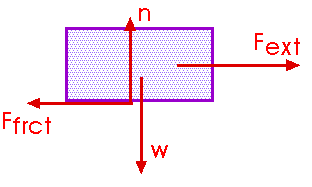An object with a mass of 18 kg is lying on a surface and is compressing a horizontal spring by 60 cm. If the spring's constant is 8 (kg)/s^2, what is the minimum value of the surface's coefficient of static friction?
1 Answer
Explanation:
The friction force is dependent on 2 factors.
The coefficient of static friction(
In the above question, the body is attached to a compressed spring, and hence the spring exerts some force on the body. This force is given as
 (Note that
(Note that
Now, we know that the body is at rest because no force is acting on it, or the vectorial sum of the forces is zero. Which means that the spring force is being equalized by the force of friction.
Now we know that the force of friction is given by
where
We know that the body is on a horizontal platform without angle, so
Since the force of friction and force of spring are equal (opposite in direction remind you), we get
Substituting the values, you'll get the above given answer.

